Lower back pain is only a symptom, an external manifestation of some disease or pathology.All pain has its cause.Back pain has many causes.
Patients are often told that back pain is caused by overuse of muscles and ligaments.Unfortunately, if the cause was only in the muscles, it would be very easy to relieve the pain.For example, a massage that brings relief.But massage does not always help, because it eliminates the cause of the pain.
Sharp back pain can occur due to a herniated disc or a bulging disc.If the herniated disc is on the right side, you may experience back pain on the right side, pain on the right side, or pain in the right leg (sciatica with large herniation).If the hernia is on the left side, you may feel pain in the left back and be bothered by pain on the left side.
If the hernia is large and compresses the left lumbar root (radiculitison the left side), then lumbago may occur in the left leg and pain may begin in the left leg.A large hernia often causes a violation of posture in the form of distortion of the trunk, with acute "twisting" pain, when it is impossible to stand up and straighten up (the so-called antalgic position of the trunk).
Right lower back pain can be caused by a hernia or problems related to the right joints of the spine, or pathology of the sacral area (right iliosacral joint).
Pain in the area of the left shoulder blade (or pain under the left shoulder blade) may be the result of a hernia or joint pathology, or heart problems.Such pain can be caused by angina pectoris and heart attack.Pain between the shoulder blades occurs not only in the pathology of the spine and osteochondrosis, but also in diseases of the stomach (gastritis, ulcers, cancer, etc.) and often in the intestines.
Cholecystitis and cholecystitis most often cause pain in the right back and under the right shoulder blade.Gallbladder pathology often presents as pain under the right rib.You need a diagnosis.
Protrusionsplates, more often incidental findings on MRI, whichit can bemove on without any pain.Disc herniation– is not such a common cause of severe back pain.Although the formation of a hernia, for example when lifting heavy objects, causes lumbar or chest lumbago (sharp back pain).In the case of constant aching back pain, the hernia found on the MRI has absolutely nothing to do with it.The causes of such constant pain are often different. Diagnostics helps you figure it out.
Therefore, in order to effectively treat back and lower back pain:
- Determine the cause of lower back pain (diagnosis).
- The cause of lower back pain is determined by a neurologist, an orthopedic traumatologist, an expert in the field of vertebrology and vertebroneurology, or a vertebrologist (vertebroneurologist).The diagnosis is established by clinical and hardware examination.
- Low back pain treatment tactics depending on the diagnosed cause.
- If you have lower back pain, it is important that the pain does not recur.To achieve this, we offer various methods, including physical rehabilitation of the spine.
Lower back pain.Why does my back hurt?
Low back pain refers to pain that is localized in the area between the 12th pair of ribs and the gluteal folds.This kind of pain is already a social problem.The fact is that the lower back is the most stressed part of the spine, which withstands daily and hourly overloads.85% of people have experienced pain in the lumbar region at least once in their life.what is the reason
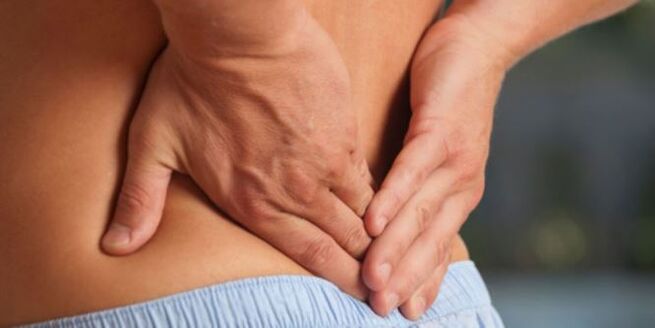
Pain in the lumbar regionthere can be many reasons.The most common causes are osteochondrosis, disc herniation, radiculitis and lumbar joint pathology.
Osteochondrosis
Osteochondrosis–natural aging of spinal tissue.
It is generally accepted that osteochondrosis is a sign of a disease of the spine, which is accompanied by pain.This is a little different.
The picture below shows that a normal disk is damaged (see the damaged disk in the picture).These damages can accelerate the aging of the disc and cause it to lose height (see intervertebral space narrowing).Then aging begins to affect the bone tissue of the vertebrae itself, and osteophytes grow (see "osteophytes" in the picture).
Previously, it was believed that osteochondrosis was associated with pain.Therefore, at that time, they tried to explain the cause of pain in the spine and lower back, especially with osteochondrosis.For this reason, even the question of the failure of vertebroneurology arose.In 1978, the first research laboratory dealing with the problems of osteochondrosis of the spine was established, which studied the issue of osteochondrosis for more than 10 years and proved that the cause of pain is not osteochondrosis, but joint pathology.
Osteochondrosis does not cause pain, since the disc has no nerve endings.Therefore, there is no pain in osteochondrosis.
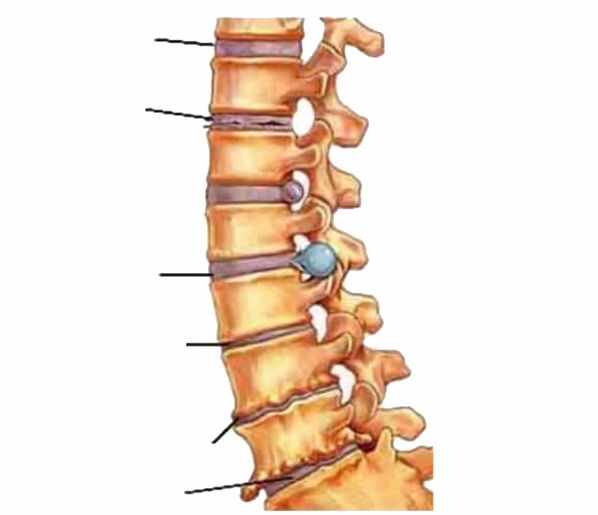
Disc herniation
Disc herniation as a possible cause of pain.The image above shows several herniated discs - a small herniated disc (protrusion) and a large herniated disc.A herniated disc itself does not hurt.

There are no nerve endings on the disc (not innervated).Pain from a herniated or bulging disc occurs when the herniated protrusion puts pressure on the innervated tissue.For example onspineor longerrearyuulongitudinalwowbundlesat.In the first case, radicular pain occurs - radiculitis (see below).In the second, when the receptors of the posterior longitudinal ligament are irritated, back pain (lumbodynia) or acute pain - lumbago (lumbago) appears.
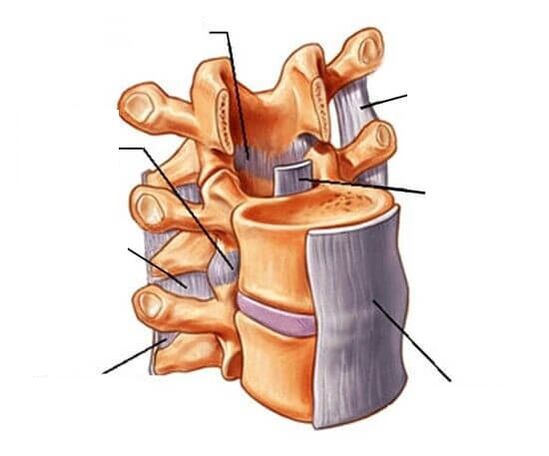
A herniated disc can often be treated without surgery.
Spondyloarthrosis
Spondyloarthrosis is arthrosis of the joints of the spine.Arthrosis itself is characterized by a disease of the articular cartilage.In this case, the height of the cartilage decreases (degenerates, "dry out"), the bone-joint surfaces lose their protective cartilage layer.The joints of the spine start to hurt.This pain is like lower back pain.
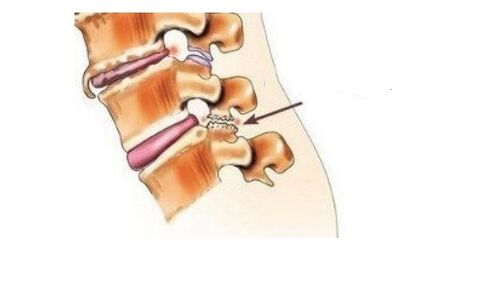
Radiculitis
Radiculitis is inflammation of the root.Radiculitis most often occurs when the root is damaged by a herniated disc or spinal joints.This is usually not so much lower back pain as pain or numbness in the legs, buttocks and toes.
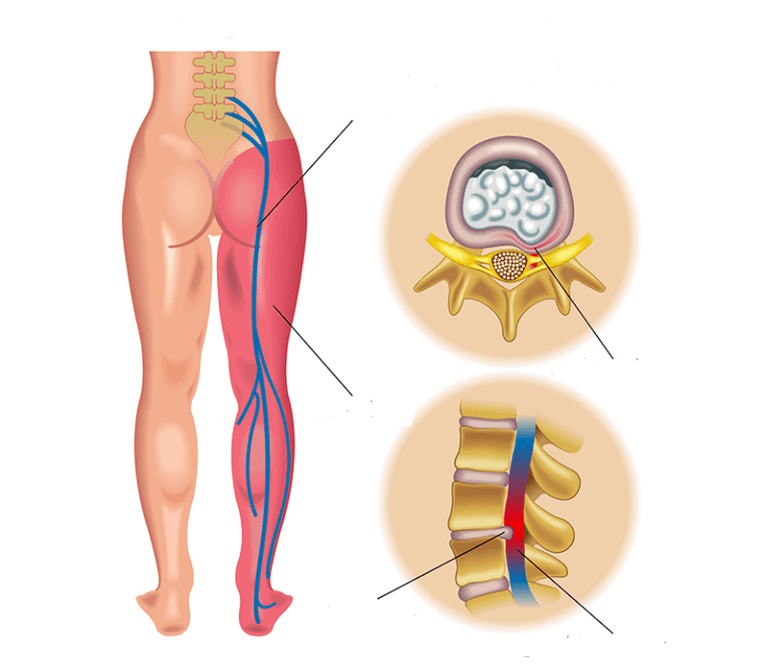
Radiculitis can be treated most effectively by freeing the root.If it is caused by a herniated disc, you need to reduce the herniation, which puts pressure on the root.
Pain in the back and lower back due to pathology of internal organs
Back pain is possible due to the pathology of internal organs.For examplelower back pain in womenit can be a consequence of diseases of the pelvic organs.
Lower back pain in women
Lower back pain in women can be caused by inflammatory diseases of the female genital organs.
If a woman has pain in the pelvis and lower back, she should always remember gynecology.Inflammatory diseases of the female genital organs are not rare.The cause may be inflammation of the appendages, inflammatory diseases of the vagina and vulva, salpingitis, salpingoophoritis, endometritis, bacterial vaginitis, etc.In women, such inflammatory diseases are more often caused by infections of the genital organs, including sexually transmitted infections.
If the lower back hurts, and at the same time there is pain in the lower abdomen, then the woman should be checked by a gynecologist.In order to initially clarify the diagnosis, a gynecological ultrasound must be performed.
Constant nagging pain in the lower back also occurs whenoncology in gynecology.
Cancer and back pain in women
Cancer does not hurt at first.When pain occurs in the lower back or sacrum area, it may be too late.
Many people think that tumors are accompanied by pain.This is wrong.In the initial stage of tumor development, a person does not feel pain.One feels practically healthy.For example, cervical cancer is asymptomatic in the genitals.It begins to manifest when the tumor grows.In this case, pain often appears in the lower back and lower back.The pain is in the lower back in the area of the sacrum.
In the case of cancer, severe pain in the lower back does not bother you at first.It's not the waist that hurts, it hurts.Such pain can be the first call that helps a woman prevent the critical growth of a tumor and make a correct diagnosis in time.If the lower part of the back or the sacrum constantly hurts, you need to pay extra attention to this so that you don't miss a disaster.
Unfortunately, if you don't pay attention to aching pain or discomfort in the lower back, the next sign of cervical cancer can be uterine bleeding.This is the stage when the tumor begins to disintegrate, when metastases can occur.Including the spine, when there is severe pain in the lower back.
Important takeaway:if your back hurts, it's not necessarily osteochondrosis or a herniated disc.And a preventive consultation with a gynecologist never hurts.After all, neck erosion detected during the examination is a cancer prevention condition.
Why does my back hurt due to urological or urogenital problems (inflammations)?
Kidney disease may be the cause of acute lower back pain
The lower back hurts severely in kidney disease, such as pyelonephritis.
Pyelonephritis is an infectious disease, most often caused by an ascending infection.It may be associated with sexually transmitted infections and other household infections spread through swimming pools, bathrooms, and personal hygiene items.For example, everything lives for a long time in an unwashed towel.
Inflammation activates pain receptors in the soft tissues of the pelvic organs.The pain signal (impulse) reaches the spine through the sensitive roots, activating its tissues.The soft tissues of the spine and the attachment points of the back muscles reflexively swell (inflame).And my back starts to hurt.
Constant back and lower back pain due to dysfunction and other diseases of the gastrointestinal tract
Intestinal spasms, bloating, ulcers or ulcerative colitis, stomach ulcers and gastritis usually cause back pain.
Stomach cancer with back pain
Treatment of back pain caused by pathology of the gastrointestinal tract does not bring improvement.The cause must be treated.
Another possible cause of lower back pain is overuse of the back
Excessive strain on the lower back is a common cause of back pain or its aggravation.Overuse often affects the lower back joints, lower back ligaments, tendons or muscles.In addition, the muscles of the lower back work actively even under load.Therefore, if you feel pain in the spine in the lumbar region after training, it is not necessarily a disease.It could be a muscle tear.If this pain does not go away within 1-2 days, then think about the problems of the lumbar spine.Especially if this pain is aggravated by movement.
The causes of such pain are often overloaded inflammation of the muscles and their connections.Or - inflammation of the joint capsules.
If such an exacerbation occurs several times a year, the cause of such aggravation should be sought.For this, it is not enough just to see a doctor and perform manipulations, take painkillers, massages and other procedures.
Investigation is needed to determine the cause of such frequent exacerbations.
Soft tissue injury of the lower back
A sharp pain in the lower back when you move awkwardly or when you lift something heavy is probably a spinal injury.
If you are concerned about pain on that side, such as right lower back pain, then think about the pathology of the joint on the right side.Or from the hernia of the lumbar spine on the right side.
Types of lower back pain
The pain can be acute, chronic or (transient) transient depending on the duration.
The pains are:
- Local pain- pain only in the lower back.
- Referred pain– when the pain occurs not only in the lower back, but also, for example, in the buttocks, in the pelvic area.Or the pathology of the internal organs causes pain in the lower back.In such cases, they speak of referred pain.
- Radicular pain– they differ significantly in intensity and are localized within the boundaries of the innervation of the root (from the spine to the periphery).The cause is a violation of the nerve root of the spinal nerve (stretching, compression, curvature, compression).Mobility or even coughing increases the pain in the so-calledcough impulse.This is severe pain in the lower back that can shoot (radiate) into the leg.
- Myofascial pain– the result of a reflex muscle spasm.The causes of myofascial pain can be diseases of internal organs or damage to the spine itself.Muscle spasm significantly disrupts the biomechanics of human movements.Chronic muscle spasms can also cause aching and cramping lower back pain.
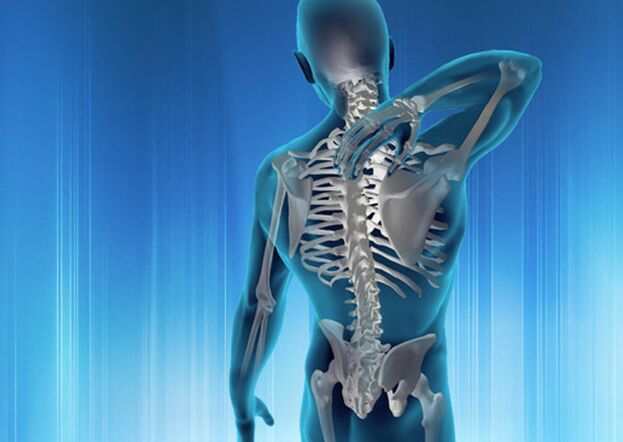
In which cases should you consult a doctor for lower back pain and what should you do?
- with sharp (acute) pain in the lumbar region;
- if back or back pain lasts more than 3 days;
- if the back pain occurred after an injury;
- if the pain is localized at the same time in the lower back, feet and legs;
- if pain in the lumbar region is combined with numbness in the thighs, buttocks, legs, feet, groin;
- if pain in the lumbar region is accompanied by twitching (twitching) of the muscles of the limbs;
- if the function of urination and defecation is impaired (urinary retention, incontinence, frequent urination or false urge to urinate);
- if the dam is numb.
- If the back or lower back pain (sacrum) is constant, it is worse in the morning
What to do if you have lower back pain?
The causes of lower back pain are varied, so lower back pain treatment should only be carried out after a diagnosis has been made and it has been set up by a qualified doctor.Any pain in the area of the vertebra requires a medical examination and clarification of the cause of its occurrence.
The doctor's visit has 3 purposes:
- Make the correct diagnosis.
- Remove the pain.
- Formulate measures to help maintain the patient's health so that the pain does not recur.
Possible causes of lower back pain
The following diseases can cause complaints of lower back pain:
- osteochondrosis;
- osteoarthritis;
- spondylolisthesis;
- spondylosis;
- ankylosing spondylitis;
- spondyloarthropathy;
- muscle damage;
- ligament damage;
- disc herniation "Herniadisc is treated without surgery in 98% of cases (world statistics);
- atherosclerosis of the abdominal aorta;
- malignant tumors of the spine;
- metastases in the spine;
- urinary tract infections;
- spinal stenosis;
- biliary diseases;
- penetrating duodenal ulcer;
- pancreatitis;
- kidney disease;
- dissection of an abdominal aortic aneurysm;
- bleeding into the retroperitoneal tissue;
- inflammatory diseases of the female genital organs;
- oncological diseases of the female genital organs;
- endometriosis;
- prostatitis;
- prostate cancer;
- abscess of the epithelial coccygeal canal;
- embolism of the arteries of the lower limbs;
- intermittent claudication;
- pseudo-intermittent claudication;
- obliterating atherosclerosis of the vessels of the lower limbs;
- rheumatoid spondylitis;
- polymyalgia rheumatica;
- fibromyalgia
- depression;
- other.
Treatment of lower back pain
At the initial stage of treatment, pain in the lower back (back) is the primary diagnosis.This is done on the basis of a survey, anamnesis, neurological and orthopedic tests.At this stage, medications may be prescribed to reduce pain, reduce tissue swelling, and provide general anti-inflammatory therapy.Reflexology, local healing effects, regional anesthesia, various injection methods for the treatment of lower back pain, laser therapy, etc. are effective.In the acute and subacute period, rest is important during drug treatment.Physiotherapy, massage, manual therapy, which can aggravate the process, are not recommended.In the acute period, traction is also not used: hardware, on inclined boards, wall bars.
To treat lower back pain more effectively, you need to understand its cause.For this purpose, the patient is further examined in order to clarify the diagnosis.Pain in the lumbar region can have many causes.Above is an informative list of diseases associated with lower back pain.Each of them has its own treatment protocol with a list of the most effective approaches, drugs and procedures.The protocols also contain data on methods that are not recommended for this disease.For example, in the case of inflammatory diseases of the spine (spondylitis, spondyloarthropathy, spondyloarthritis, myositis, ligamentitis, etc.), manual therapy, massage and physiotherapy are not recommended due to ineffectiveness and the risk of complications.It is necessary to identify the cause of the inflammation and treat it.
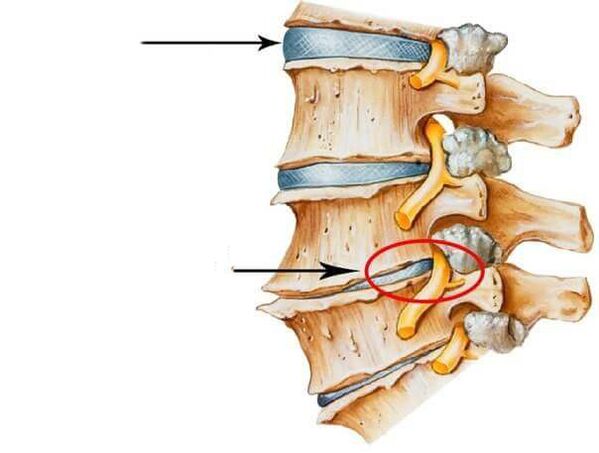
Spondylosis seen on radiographs can occur without clinical symptoms and often masks a more complex disease.Therefore, the treatment of spondylosis is useless and often dangerous: removing bone growths in the spine is unrealistic and unnecessary.The patient may encounter such exotic diagnoses as "muscle damage", "muscle spasm", "ligament damage".Unfortunately, talking about muscle spasms as the cause of pain is not always true.Muscle spasm of the paravertebral muscles is a reflex act and usually accompanies most diseases, including those not related to the spine.The muscles are actively involved in the segmental reflex process and can respond to any irritation both inside and outside the spine.The so-called "spasms" must be distinguished from reflected or projecting back pain, which can be caused by the pathology of internal organs: diseases of the pelvic organs, retroperitoneal space, kidney, pancreas and prostate, gynecological diseases of inflammatory or tumor origin, diseases of the aorta, bleeding into the retroperitoneal tissue.Osteopathic techniques of working with secondary spastic paravertebral muscles can temporarily alleviate the condition at the reflex level.Manual therapy, osteopathic techniques, incline plank, massage, traction, physiotherapy, for example, do not help with prostatitis or adenomatosis.The so-called "therapeutic removal"."Muscle spasms" in this case are just the desires of the manipulator.
Treatment of herniated discs and protrusions in the lower back
An MRI often reveals a hernia or protrusion that is interpreted as the cause of lower back pain.The question immediately arises: remove the hernia or try to cope without surgery?
The first thing to do- clarifies how clinically significant this hernia is.The thing is, if you take 100 perfectly healthy people with no lower back pain and do an MRI scan, 80% of them have some sort of disc protrusion ("herniated") that doesn't cause any symptoms.
A herniated disc can often be an incidental finding, often attributed to another cause of pain.
At the same time, practice shows that not all hernias are clinically significant.To clarify the causes of the pain, a thorough medical history is taken, a neurological examination is performed to identify neurological deficits, the functioning of the pelvic organs is clarified, etc.
It turns out that not all disc herniations and protrusions require surgery.No more than 2% of patients require such surgery.
Neurosurgeons have prescribed absolute indications for surgery, which are clearly defined.Most often, the presence of a herniated disc is not a reason for emergency surgery.
A sufficient arsenal is available to treat disc herniations and protrusions, including traction, establishing stable motor patterns of the back, methods of local and general drug therapy, physiotherapy, reflexology, etc.Calibrated treatment without surgical intervention is often accompanied by regression of symptoms, and the hernia (protrusion) may decrease over time.

When making a surgical decision, the relative indicators of surgical treatment, which are officially prescribed by neurosurgeons, should be taken into account.We consider each specific case separately, taking into account the clinical symptoms, medical history, anamnesis, neurological and orthopedic examinations, and the results of hardware and laboratory tests.
It should be emphasized that surgical intervention is often associated with numerous complications, which often have to be dealt with more intensively after surgery than with pain relief before surgery.
Degenerative changes of the spine, such as osteochondrosis, spondyloarthrosis, spondylosis, etc., are treated based on the identification of the root causes of the pain syndrome.
Massage and manual therapy are quite effective treatment methods if there are indications for their use.Over the past three decades, the Institute has developed optimal protocols for the treatment of patients with low back pain, taking into account the possible range of causes.

















































